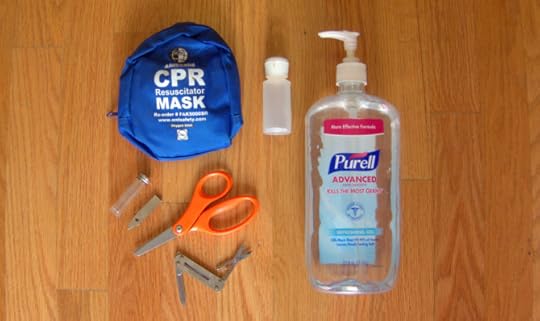Gear List: Backpacking First Aid Kit for soloists & groups
A first aid kit is rightfully considered by most backpackers to be a must-have item. To check this box, you have two basic options:
Purchase a prepackaged commercial version like the Adventure Medical Kits Ultralight that has been vetted by medical professionals; or,
Create your own, based on the specifics of your group, itinerary, and environmental conditions.
Commercial kits are convenient, but they’re expensive for what you get and they don’t necessarily address all of your needs. A DIY kit is research-intensive and more time-consuming, but it’ll be perfectly optimized for you.
If a DIY/MYO kit seems preferable, keep reading.
Gear list: Backpacking First Aid Kit for soloists and groups
Over the past twenty years, I have backpacked solo over 30,000 miles and have led 100 guided groups with nearly 800 clients, in locations throughout North America, primarily the Rocky Mountains, High Sierra, Appalachians, Desert Southwest, and Pacific Northwest.
My solo and group first aid kits are based on what I’ve encountered during these experiences, which I’ve detailed previously. My selections are not based on fear or first aid training simulations.
Open this list in its own window.
Critical: A must-have, no exceptions
Suggested: A valuable addition, few reasons not to bring
Optional: Not critical, but worth consideration
Contingent: Depends on trip objectives, conditions, and/or other selections
Unnecessary: Unlikely to need and/or can be improvised
What can you actually treat?
With your first aid kit, you should be able to manage or treat fully:
Minor cuts, burns, and scrapes;
Overuse aches and pains;
Minor allergic reactions, diarrhea, and acute mountain sickness; and,
A few other minor things.
Limitations
A first aid kit is not a get-out-of-jail-free card. In any medical scenario that would be considered more than “minor,” you’re looking at a self-rescue or an assisted evacuation. It’s wise to have small-scale overview maps and a satellite messenger/phone for these situations.
Also, a first aid kit is not a substitute for being smart! You’ll be best served by researching likely environmental and route conditions before you leave, and then using common sense in the field by identifying risks, respecting your limits and those of your group, and making conservative decisions.
Finally, carrying a first aid kit does not translate into knowing first aid. For that, consider getting some training through organizations like Red Cross, NOLS, WMAI, and SOLO.
CPR certification, at a minimum, for everyone; and,
Wilderness First Aid or Wilderness First Responder for trip leaders and avid soloists
Photos
The list above is my definitive/recommended kit, and it’s updated every spring at the start of my guiding season. The photos below were taken a few years ago, and some items or form factors have changed since then.
 Medications
Medications Wound care
Wound care Tools
ToolsCost of a DIY kit
A DIY kit may be a greater up-front investment than a commercial kit, because you often have to buy more than you need. For example, a bottle of ibuprofen normally has 50+ pills, but you’ll need just 10 for an upcoming solo weekend trip. However, a DIY kit will be less expensive in the long-run as you replenish items that you use.
With the unneeded quantities of a DIY kit, create additional first aid kits for your home and vehicle(s).
Solo versus group kit
On a group trip, medical situations are more likely and more diverse in nature, simply due to there being more people, each with a unique medical history. Appropriately, then, my group first aid kit is more robust than what I carry when solo — I bring more items and greater quantities of each item.
My solo kit is a slimmed-down version of my group kit. For example, I leave behind aspirin (which I don’t need, but which I might give to an older group member with symptoms of a heart attack) and disposable gloves (since it’s okay for me to be in contact with my own bodily fluids), and I bring a smaller utility tool because I likely will not use it as much.
Amounts
The amount of each item I carry is a function of the trip duration, group size, and my sense of its importance. My philosophy is this: If I really need an item, I want to have enough to address fully the medical event.
For example, if I come down with iliotibial tendentious (“runner’s knee”) I want enough anti-inflammatory medications so that I can take full dosage until I exit or arrive at the next town with a drugstore. And if I were to badly cut myself, I want enough wound dressings and tape to treat it properly.
Kit weight
I have never weighed my first aid kit. If you do, you are welcome to share what you get. But, frankly, its weight is irrelevant: my kit has what I need and not much extra (or any extra), and knowing its weight would not prompt me to reconsider its contents. If I were striving to be an “ultralight” backpacker (whatever that means), my approach towards first aid would be no different.
What do you think of my first aid kits? What other items do you take (or leave behind)?
Disclosure. I strive to offer field-tested and trustworthy information, insights, and advice. I have no financial affiliations with or interests in any brands or products, and I do not publish sponsored content
This website is supported by affiliate marketing, whereby for referral traffic I receive a small commission from select vendors like Amazon or REI, at no cost to the reader.
The post Gear List: Backpacking First Aid Kit for soloists & groups appeared first on Andrew Skurka.



